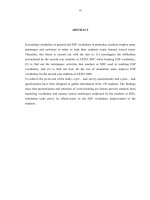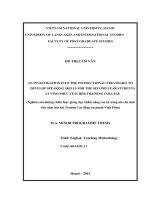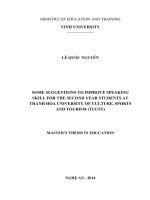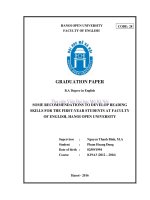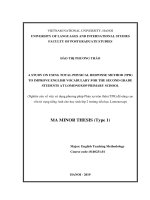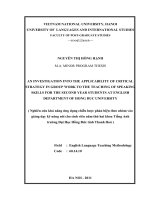Some suggestions to improve speaking skill for the second year students at thanh hoa university of culture, sports and tourism (TUCST)
Bạn đang xem bản rút gọn của tài liệu. Xem và tải ngay bản đầy đủ của tài liệu tại đây (1004.86 KB, 89 trang )
MINISTRY OF EDUCATION AND TRAINING
VINH UNIVERSITY
LÊ QUỐC NGUYÊN
SOME SUGGESTIONS TO IMPROVE SPEAKING
SKILL FOR THE SECOND YEAR STUDENTS AT
THANH HOA UNIVERSITY OF CULTURE, SPORTS
AND TOURISM (TUCST)
MASTER’S THESIS IN EDUCATION
NGHỆ AN - 2014
2
MINISTRY OF EDUCATION AND TRAINING
VINH UNIVERSITY
LÊ QUỐC NGUYÊN
SOME SUGGESTIONS TO IMPROVE SPEAKING
SKILL FOR THE SECOND YEAR STUDENTS AT
THANH HOA UNIVERSITY OF CULTURE, SPORTS
AND TOURISM (TUCST)
Major: Teaching English to Speakers of Other Languages (TESOL)
Code: 60.14.01.11
MASTER’S THESIS IN EDUCATION
Supervisor: M.A. PHAN THỊ HƯƠNG
NGHỆ AN - 2014
4
STATEMENT OF AUTHORSHIP
I hereby acknowledge that this study is my own work. The data and findings
discussed in the thesis are true, used with permission, and have not been published
elsewhere.
Author
Lê Quốc Nguyên
v
TABLE OF CONTENTS
vi
ACKNOWLEDGEMENTS
I would like to express my sincere thanks to my supervisor Mrs. Phan Thi
Huong for her precious advice, practical suggestions and constant encouragement in
the preparation and completion of this graduation paper. Without her help this
graduation paper would not have possibly been completed
I wish to take this opportunity to express my heartfelt thanks to the teacher of
Department of post- graduate studies who supply me with the good conditions to
conduct this thesis and finish This M.A course.
I would be also grateful to the teachers and students at Thanh Hoa University
of culture, sports and tourism for their assistance and unwillingness to permit me to
observe their classes, interview and to answer my questionnaire.
Due to the limited scope, mistakes in this graduation paper are inevitable.
Therefore, I hope to receive further comments and advice from the readers to make
it better.
1
ABSTRACT
This thesis aims to find out the difficulties in teaching and learning speaking
skill that teachers and non-English major students encountered at Thanh Hoa
University of Culture, Sports and Tourism and give some suggestions for
developing the students’ speaking skill.
The study includes three main parts. The study begins with the introduction,
which includes rationale, scope of the study, aims of the study, significance of the
study, methodology and design of the study. Part two includes three chapters in
which the first chapter presents the related literature, the second chapter, the heart of
study, gives a brief introduction of Thanh Hoa University of Culture, Sports and
Tourism, describes the study in detail, the third chapter deals with the summary,
finding and pedagogical implications of study. Part three is the conclusion, which
focuses on the summary of the research.
2
LIST OF TABLES, GRAPHS AND FIGURES
Table 1: Teachers’ experience of teaching
Table 2: Difficulties from Students
Table 3: Teacher pedagogical Practices in teaching speaking skill
Table 4: Students’ opinions on inappropriate teacher pedagogical
practices in English speaking lessons
Table 5: Teachers’ English communicative competence
Table 6: Students’ history of learning English
Table 7: Students’ time of learning English
Table 8: Students’ attitude towards speaking skill
Table 9: Factors making the students unwilling to speak in class
Table 10: Students’ difficulties in learning speaking
Table 11: Students’ interest in speaking
ABBREVIATIONS
TUCST: Thanh Hoa university of Culture, Sports and Tourism
STT: Student talk time
TTT: Teacher talk time
EFL: English as foreign Language
ESL: English as Second Language
GE: General English
ESP: English for Specific Purpose
ELT: English language teaching
CLT: Communicative language Teaching
No of Students: Number of Students
No of Teachers: Number of Teachers
3
PART A: INTRODUCTION
1. Rationale
Nowadays, English plays an important role in all over the World. People use
English in most of areas, like science, technology, business and commerce,
international relations and so on. English is a useful bridge to help people from
other countries understand and say a same language. It is the main language of most
international organization like NATO, European free trade Association. Most all
international conferences and competitions use English. For example; miss World
contest and World cup. Now Internet and mobile phone are very popular to contact
people from all the world and the language for them are written in English. Adult
and children from different counties can talk, share the idea and learn about the
culture through Internet and Mobile phone by English. Someone can travel around
the world if he can speak English well and so on. In Vietnam, English has been
taught from primary level and in most of final test student have to pass English
exam as an essential requirements
Mai Thanh Thu (2008,) in her research about speaking difficulties which
students faced when they studied speaking, mentioned that Speaking is one of four
important skills that should be paid attention to in the process of teaching and
learning. The goal of learning speaking should improve students’ communicative
skill, by that way, students can express their ideas. But in fact, a large number of
students at Thanh Hoa University of Culture, Sports and Tourism find it difficult to
speak in English as they have to think for a long time about what they intend to say
before they can actually speak some words. Even worse, some cannot speak any
English at all.
When students speak English badly, one tends to blame the students for having
poor ability or making insufficient effort. However, there are other important
factors in teaching and learning process that should be taken into consideration such
4
as interest, teaching materials, attitude of teachers and students toward the subject,
etc.
For the above-mentioned reasons, the author has chosen to do a study entitled
“Some suggestions to improve Speaking skill for the second year students at
Thanh Hoa University of Culture, Sports and Tourism (TUCST)”
This study will try to find out problems and suggest some solutions to improve
the teaching and learning English speaking skill for students at TUCST.
2. Scope of the study
The researcher doesn’t think that he will deal with all speaking problems of
current materials used for non major students of culture management in this study.
It is too broad. Therefore, the focus of this study is to investigate speaking
difficulties experienced by teachers and non- English major students of culture
management at TUCST when using the course book “Life lines”, then suggest
solutions to the problems in order to help students improve their speaking skill.
3. Aims of the study
The study is carried out with aims to:
- Investigate the students’ attitude toward speaking skill
- Investigate teachers and non- English major students’ areas of speaking
difficulties
- Give some suggestions to solve the problems so as to improve teaching
and learning speaking skill.
In order to achieve the aims set forth, the following research questions are
posed.
1. What are the difficulties met by the second year students of culture
management when they learn speaking skill at Thanh Hoa University of Culture,
Sports and Tourism?
2. What are the difficulties for the teachers in teaching speaking skill?
3. What are effective solutions to those difficulties?
4. Significance of the study
5
The study is expected to enhance teaching method of speaking to the second
year students and the students’ learning of speaking skill.
5. Methodology
The study will be carried out based on material collection and survey
questionnaires.
For the theoretical basis, reference materials on speaking from various sources
are collected, gathered, analyzed and synthesized considerately for the content of
the intended thesis.
For the practical basis, the researcher chooses the survey research with two
survey questionnaires and interview for teachers and second year students of culture
management at TUCST
6. Design of the study
The study is divided into three parts.
Part A is Introduction, presents the rationale, the aims, the scope, the
methodology and the design of the study.
Part B is Development. It consists of three chapters.
Chapter 1 reviews the theoretical background, which is relevant to the
purpose of the study.
Chapter 2 gives a brief introduction on the materials and current situations of
teaching speaking at TUCST and describes the research methodology, which
focuses on the context of the study, participants, the instruments and data collection
procedure.
Chapter 3 deals with data analysis and some suggestions
Part C is Conclusion, summaries the study and offers some suggestion for
further research.
6
PART B: DEVELOPMENT
CHAPTER 1: THEORETICAL PRELIMINARIES
1. The nature of speaking
1.1. Nature of Language skills
For the purposes of analysis and instruction, language has been divided into the
four skill areas. These can be discussed in the framework of how we learned our
first language. When we were a child we first learnt to practice language through
the skill of listening. Later, we used language by speaking combined with listening.
Then, at school stage, children learnt the skills of reading and writing. The first two
skills, listening and speaking, are called the oral skills due to the manners by which
they are formed. The last two, reading and writing, are called the literacy skills as
they connect with manual script.
When children grow in their language ability and use, they don’t use individual
skill, they use skills more flexible and know to combine other skills to make a
completed conversation such as they can listen while they are speaking, they can
read while they are writing. As a teacher, you will be reading your lesson plans and
then speaking to your students. All of the skill areas are related to each other and
used in coordination with each other.
Many studies showed that some learners are very good at memorizing words and
grammar rules, but they still cannot speak well. They can read better than they
speak. A child doesn’t learn to speak like this, he learns to listen then he imitates to
speak long before learning to write and read.
These studies help us know that it is better to begin with speaking, because after
learning to speak, it is easier to develop reading and writing skills in the foreign
language classroom. But, language teachers have found it is difficult to develop
their students’ speaking skills after reading and writing
1.2. Definition of speaking
7
Speaking is regarded as very important for language teaching and learning.
Speaking is a bridge to reach other skills. It helps learners to read better, to listen
more effectively and to write more accurately. Speaking is surely the most effective
means of communication. (Ur, 1996)
Brown (1983) also states that “Speaking is an interactive process of constructing
meaning that involves producing, receiving and processing information”. From this
state, we see that speaking is a complex process and its content depends on the
context, purposes of speaking, participants take part in the process and
communicative skill of speakers and listeners.
Mai Thanh Thu (2008) carried out researched on some difficulties which
students faced in speaking. She also stated that:
It is often spontaneous, open ended and evolving. However, speech is not
always unpredictable. Language functions that tent to recur in certain discourse
situations (declining and invitation, requesting time off from work) can be identified
and charted. Speaking requires not only that learners know how to produce specific
points of language, such as grammar, pronunciation, vocabulary (linguistic
competence), but also that they understand when, why and in what way to produce
language
Scott (1978) reveals that “speaking can be typified as an activity involving two
or more people in which the participants are both hearers and speakers having to
react to what they hear and make their contribution.” In speaking activity, the
speaker and hearer have their own idea or intention, they usually can’t predict what
will happen next but base on the context, they will give their opinion and try to
explain or defense their idea.
Each has an intention or a set of intentions that he wants to achieve in the
interaction and an ability to interpret what is said to him which he cannot predict
exactly either in terms of form or in terms of meaning.
8
“Speaking is such a fundamental human behavior that we don’t stop to analyze
it unless there is something noticeable about it” Nguyen Thu Linh (2008). To
approve the ideas she gave example:
if a person is experiencing a speech pathology (if a person stutters or if his
speech is impaired due to a stroke or a head injury), we may realize that the speech
is a typical.
Likewise, if someone is a particularly effective or lucid speaker, we may notice
that her speech is atypical in a noteworthy sense. What we fail to notice on a daily
basis, however, are the myriad physical, mental, psychological, social, and cultural
factors that must all work together when we speak. It is even a more impressive feat
when we hear someone speaking effectively in a second or foreign language.
There are a lot of concepts of speaking. Each researcher gives his own idea and
tries to approve that it is true. But all of them agree that speaking is very important
skill, and they all try to find out the nature of speaking, speaking act, in which the
speakers, speaking process, and speaking message are emphasized.
1.3. Spoken language and communication
Speaking is the productive, oral skill. Speaking consists of producing systematic
verbal utterances to convey meaning (utterances are simply things people say).
Speaking is “an interactive process of constructing meaning that involves producing
and receiving and processing information” (Florez, 1999, p.1). It is “often
spontaneous, open-ended and evolving” (ibid., p.1), but it is not completely
unpredictable.
Communicative activity is a complex process. When communication takes place
speakers and hearers usually change their turns. At that time they themselves feel
that they want to speak out or write down something they want to express their idea
and share their opinion with the others.
In oral communication process, the roles of speakers and listeners are
interchanged; information gaps between them are created and then closed with the
effort from both sides. In organizing classroom oral practice, teachers should create
9
as much information gap as possible and teachers’ vital duty is to encourage
communication which yields information gaps. Teachers should also bear in mind
the differences between real-life oral communication and classroom oral
communication.
According to Broughton (1980:25), “all living creatures have some means of
conveying information to others of their own group, communication being
ultimately essential for their survival;” beside the verbal communication, man uses
the non- verbal communication to communicate each other. But they mainly
communicate through spoken language. Today, it is commonplace to say that
“Language is never used for its own sake, but always for the sake of achieving an
objective, or to perform a function, to persuade, in form, inquire, threaten, etc.” (Ur,
1981:3).
Brown and Yule’s opinions (1983), spoken language consists of short,
fragmentary utterances in a range of pronunciation. However, speaking is a skill,
which deserves attention as much as literacy skills in both first and second language
because our learners often need to speak with confidence in order to carry out a lot
of their most basic transactions (Bygate, 1991). Furthermore, speaking is known
with two main types of conversation called dialogue and monologue.
Wright (1987), we speak because of the following reasons:
Giving or asking for factual information
Expressing what we think and find out what someone else thinks.
Expressing what we feel and find out what someone else feels.
Expressing what we think is right or wrong…etc.
1.4. Types of speaking
There are two major types of speaking: monologue and dialogue
1.4.1. Monologue
Brown and Yule’s opinion (1983), “a monologue involves the ability to give an
uninterrupted oral presentation such as when a broad caster reads news in radio or
10
television programs, a teacher or professor gives a formal lecture, an announcer
gives the instruction or changes in the airport, etc”.
This type corresponds with non-reciprocal listening where the transfer of
information is in one-direction only from the speaker to the listener and is used like
the written form with no reaction and response from the listener. These types take
place when the speaker wants to talk with a large number of listeners about the
same issue.
1.4.2. Dialogue
As we mentioned monologue usually involved in individual and “in one-
direction only from the speaker to the listener and is used like the written form with
no reaction and response from the listener” Thu Mai Thanh’s opinion (2008).
Contract this, a dialogue are usually carried out between two or more people. in
dialogue people listen and speak they change their turn follow the situation and
condition. They change their turn and share their idea directly.
Donne Byrne (1986) also says: “Dialogues seem to be best suited to the teaching
of the spoken language”. In this study, the researcher will use the dialogue as an
effective way to improve speaking skill for non-major students of culture
management at Thanh Hoa University of Culture, Sports and Tourism.
1.5. Speaking skill
Many language learners think that you can master a language if you speak
fluently; it seems that speaking ability is the measure of knowing a language. As for
them, fluency is the ability to converse with others much more than the ability to
read, write or comprehend oral language. Language learners regard speaking is
most important skill they can’t get progress in acquiring language if learners do not
learn how to speak or do not get any opportunities to speak in the language
classroom, they may soon get de-motivated and lose interest in learning. On the
contrary, if the right activities are taught in the right way, speaking in class can be a
lot of fun, raising general learner motivation and making the English language
classroom a fun and dynamic place to be.
11
The skill of speaking has been recently considered by many methodologists a
priority in language teaching. Of all the four skills, Ur (1997: 120) concludes,
speaking seems intuitively the most important. Most language learners, she adds,
are primarily interested in learning to speak.
In Nguyen Thi Thu Linh’s study(2008), she carried out to compare some
researchers’ view about concept of speaking skill and showed that Numan has
similar view, he says that “the ability to operate in a second language can be
actually equated to the ability to speak that language”. Another researcher shares
the same idea that Hedge, he gives the evidence that speaking has recently obtained,
at least from textbook writers, the attention it deserves: “Learners need to develop at
the same time knowledge of grammar, vocabulary, functional language and
communicative skills. Attention to the systems of language is crucial, but the
development of fluency and contextual appropriacy are equally important goals”.
Speaking is fundamental to human communication. Different linguists have
different concepts of speaking but they all agree with this idea.
Brown (1994) defines speaking as an interactive process of constructing
meaning that involves producing, receiving and processing information.
In Brown and Yule’s opinions (1983), spoken language consists of short,
fragmentary utterances in a range of pronunciation. Usually, there is a great deal of
repetition and overlap between one speaker and another. Speaker usually uses non-
specific references. They also add that spoken language is made to feel less
conceptually dense than other types of language such as prose by using the loosely
organized syntax, and non- specific words, phrases and filters
1.6. The role of the teacher and students in teaching and learning
speaking
1.6.1. The role of the teacher
The goal is not only to get students to speak and share thinking but also to have
them learn and develop through speech. As students’ language skills develop,
classroom talk and discussion can be directed toward the goals of exploring ideas
12
and facts found in texts and in the subsequent development of thought and
deepening of knowledge.
Gillian Bertram (2002) claims that to act as facilitators of student learning,
teachers should:
Encourage students to bring their ideas and background knowledge into class
learning activities.
Be a responsive listener to students’ talk.
Nature an accepting environment where students will feel free to express
themselves without fear of censure by adult or fellow students.
Raise questions concerning the activities or conversations held with students.
Promote robust discussion and exposition amongst class members.
Provide opportunities for speaking, discussion, and expression of ideas,
experiences and opinions across the whole curriculum. This will involve a range of
experiences which the size and type of audience, the situation and purpose will all
vary.
Present themselves as good models of oral language.
Establish strategies to manage all form of communication to ensure all students
have fair and equitable opportunities to develop their interpersonal speaking and
listening skills, e.g. small and large group work discussions.
Donn Byrne (1976:3) has a clearer explanation for the teacher’s roles as follows:
* The teacher acts as an informant at the presentation stage
In this stage, teacher knows clearly items what he/she is going to present,
teacher chooses the useful ways and new material to present, he/ she will organize
the lesson in the way to save time and make it most clearly to understand and
remember. The students listen to the teacher’s presentation and try their best to
understand and memory. In this stage, the students only listen and memory, teacher
controls all class activity, but teacher has to know that he must save time, present
the new items clearly and as fast as he can. This act saves time for students to
practice at next stage
13
* The teacher as a conductor and monitor at the practice stage
At this stage, teacher finishes his presentation, student understands and
remembers the new items, teacher talking time is less and student talking time
increases. Now, teacher’s role is an instructor and observer. The students practice
what they are introduced. In this stage, teacher doesn’t introduce new item but,
while student are practicing they can ask their teacher to explain or instruct more if
they get troubles
* The teacher as a guide at the production stage
At this stage, the students are given enough new language item, they have just
practiced the new language item in the practice stage. But they haven’t known to
use language in real life and this is a big problem in learning speaking skill. Most of
students at Thanh Hoa University of Culture, Sports and Tourism usually said that
they don’t know why they have to learn English; they don’t know to use what they
learnt in real life. so, this stage, students have much more changes to apply what
they have learned into real life, they can use language to express their idea and
share their view with their partners so they will understand that they have learned
something useful to them, it also encourages them to continue learning. In this
stage, the teacher continues guiding students to practice.
1.6.2. The role of learners
“Students are communicators. They are actively engaged in negotiating
meaning- in trying to make themselves understood – event when their knowledge of
the target language is incomplete. They interact with one another in various
configurations; pairs, triads, small groups and whole class. Since the teacher’s role
is less dominant than in a student- centered method, students are seen as more
responsible managers of their own learning” Nguyen Thi Thu Linh (2008). One of
the basic assumptions of Communicative Approach is that the students will be more
motivated to study a foreign language if they feel they are learning to do something
useful with the language they study.
14
Mai Thanh Thu (2008), in her research about the difficulties which the non-
English major students got when they study speaking skill, reveals that” The aim of
teaching speaking is to enable learners to communicate effectively and successfully
in real life”. In Nunan’s view (1998: 80). To meet this aim the learners have take
the following roles:
- The learner is the passive recipient of outside stimuli
- The learner is an interactor and negotiator who are capable of giving as
well as taking.
- The learner is a listener and performer who have little control over the
content of learning.
- The learner is involved in a process of personal growth.
- The learner is involved in a social activity and the social and inter-
personal roles of the learner cannot be divorced from psychological learning
process
- The learner must take responsibility for their own learning developing
autonomy and skills in learning how to learn.
1.7 Stages of teaching speaking
According to Methodology course 1- Teaching the skills (Ha Noi 2002: 42-43)
there are three stages in a speaking lesson: pre-speaking, while- speaking, and post-
speaking. Each stage the teacher and the learner has their own activities and in each
stage, speaking activity has its own characteristics.
1.7.1 The pre - speaking stage
As we mentioned about the teacher’s role in teaching speaking skill. At first
stage, the teacher talking time is much, he/ she dominates class activities. It is the
same way, in pre- speaking stage, teacher is the centre. He will present new items
and introduce it to students, he organizes his lesson in the way that student can
understand and memory the new language items easily. Contract the teachers’ roles.
In this stage, students only listen and observe teacher’ introduction.
15
So far, oral materials are written mainly in two forms in every course book.
They are dialogue and prose. And obviously these two forms must be presented in
defend ways.
According to Byrne (1991:22) introduction of the procedure in which the ten
different steps are used to present a dialogue. They are:
Establish setting by using pictures (at this phrase English should be used as
much as possible)
Draw out learners’ experience related to situation.
Explain some key words.
Set listening task by asking key information of the dialogue.
Ask learners to listen without looking at the books.
Allow learners to have a look at their books when necessary.
Ask the learners to listen and repeat
Ask learners to pick up difficulties (good chance for learners to soak) and
explain difficulties.
Ask them to practice ( Role- play)
Ask learners to dramatize the dialogue.
What’s more, the presentation of prose massage suggested by Byrne (1991: 26)
includes the nine steps:
Introduce the topic by asking the students to have a quick look at the picture or
by asking them about a related book, film, or TV programme they have seen.
Introduce the text including new words or new structures. However, there is no
need to explain all things in the text.
Provide relevant language practice, for example, train the students with
pronunciation drill so that they can speak English easily, fluently and also help
them remember the new words.
Set the reading task by making questions
Ask the students to read the silently
Read the passage aloud
16
Explain any difficulties faced by the students
Do silent reading again
Get the students to talk about what they have learned
The two ways presentation is said by Byrne they are very useful for presenting a
dialogue and prose. But, we can’t apply all of steps in every situation we have to
base on the participants, lesson’s need and the situation of teaching and learning to
apply. It means that in some cases we can follow all the steps but in another cases,
some steps are not very necessary we can’t leave it out
1.7.2 The while - speaking stage
At the pre-speaking stage. Teacher is the centre, he dominates all class activities,
students are the hearer, and they have to listen and memory the new language items.
But, in this stage, the teacher talking time is less. Now it is the students’ turn, the
students have much more time to practice, the aim of this stage is to improve
students’ speaking skill, the teacher lets students with their partners, they can work
in pair or groups. The main purpose of this stage is to improve students’ speaking
skill, to help them speak fluently so the teacher shouldn’t care much about the
students’ mistakes, the teacher shouldn’t stop students when they are speaking. In
this stage, teacher plays a monitors’ role and help the weaker student if they can’t
follow the others.
1.7.3 The post - speaking stage
This stage is time for learners to speak English, at pre- speaking and the while-
speaking stage, Learners are the role of listener, most of time, and their teacher
gives instruction and practice. At the post- speaking stage, students are given more
chances to practice freely. A real chance to speak English takes place when the
learners are able to use English naturally for themselves, not for their teacher. To
practice effectively, teachers should ask learners to work in pairs or work in group.
Group work and pair work play an important part in making learners practice
speaking. By doing group work and pair work, all learners can have chance to
participate in task. Time can be saved and learners seem more confident.
17
In the while- speaking stage, the students are required to practice, but they have
to practice follow some models and at the post – speaking stage, the students
continue practicing, they do an extension speaking activity, it helps students to
express and share their view to another groups or partners. Through this, students
feel they have studied something meaningful, they can use language for their own,
they know how to apply what they have studied in real life. the teacher in this stage
must take on the role of a manager or a guide in order to give feedback, correct
serious mistakes, give students marks and set personal goals for improving their
speaking abilities.
Byrne (1988:2) concludes that in order to improve speaking ability of learners,
three phases above should be followed orderly. But in fact, they might not be
applied as expected due to time limitation, types of learners and materials in use.
The phases can be overlapped or run into one another provided that we keep our
aim to get the learners to communicate. However, teachers ought to pay attention to
what has been spoken by the students during the Practice and Production phases so
that they can see how far students have improved their speaking ability and what
mistakes they might produce.
1.8. Problems with speaking
There exist many student-related problems in teaching speaking skill in English
classes. Many learners, as reported by studies into speaking (e.g. Tsui: “Reticence
and anxiety in second language learning”), are shyness when talking, Thinking of
what to say in Vietnamese then Translating into English, Teacher-learner
relationship; Objective factors in English oral classes pose a big challenge for
teaching speaking skill.
1.8.1. Students’ Difficulties in learning speaking
1.8.1.1. Fear of making mistake:
When students begin studying English they are not self- confident to speak, they
are fear of making mistakes. This difficulty seems due to a number of reasons.
18
Firstly, when asked to speak English in classroom students don’t have an idea
about the subject. They may don’t know about what they are learning to do. Their
knowledge about the subject is not very much, so they can’t speak. I think the
starting point of every lesson should be an operation of some kind, which students
might actually want to perform in the foreign language.
Moreover, some students have an idea but they can’t speak out, so why? Some
surveys showed that learners are usually worried about what the others might say or
think. Before speaking they always think that they will speak incorrectly and their
friends will laugh at their mistake in pronunciation or in grammar. All of these
reasons make them keep silent during the period. In addition, student may have an
opinion, but do not feel that they can say exactly what they mean. They are afraid
they might not be able to put their words and the opinions in order, to make other
understand their ideas easily.
The next reason makes learners can’t speak that is, students have a good idea,
but want to express it in same eloquent manner that they are capable of their mother
tongue. They forget that the way or the rule of expressing ideas in English and
Vietnamese is different. Also, the grammar, the words order and intonation of
Vietnamese are very different to English. Moreover they always think of what they
are going to say in Vietnamese first then translate into English. This make them
think slowly and the order of the words in the sentences may be wrong. One more
reason for students making mistakes in speaking class may come from their teacher
who believes that some small mistakes of grammar or pronunciation do not matter
as long as the student gets his message across. In some language classroom,
students haven’t been prepared well about what they are going to speak, they may
be forced in to activities and in an effort to deal with them they make mistake
because they to do something they have been shown how to do, or they have not
mastered sentence the all construction so it’s not really a mistake at all.
19

